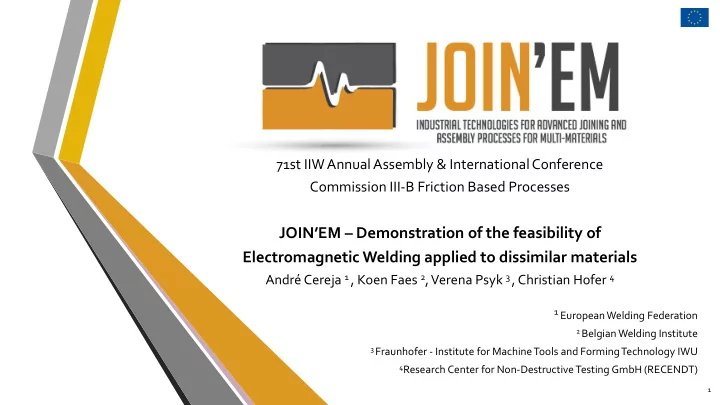

71st IIW Annual Assembly & International Conference Commission III-B Friction Based Processes JOIN’EM – Demonstration of the feasibility of Electromagnetic Welding applied to dissimilar materials André Cereja 1 , Koen Faes 2 , Verena Psyk 3 , Christian Hofer 4 1 European Welding Federation 2 Belgian Welding Institute 3 Fraunhofer - Institute for MachineTools and FormingTechnology IWU 4 Research Center for Non-Destructive Testing GmbH (RECENDT) 1
Overview • Facts and Figures • Motivation and Expected Results • JOIN’EM Video • Electromagnetic Pulse Welding (EPW) • Analysis of the joining process • Development of joint characterisation methods • Development of multiscale simulation strategies • Tool development • Development of industrial demonstrators • JOIN’EM Results • Conclusions 2
Facts and Figures • Project: JOINing of copper to aluminium by ElectroMagnetic fields (JOIN’EM) • Call: FoF-12-2015, Industrial Technologies for advanced joining and assembly processes for multi-materials • Duration: 01.09.2015 - 31.08.2018 • Budget: 4.7 M€ • Coordinator: Fraunhofer IWU • Website: join-em.eu 3
Motivation and Expected Results • Copper: 3 rd most used material in the world • State of art: heavy use of full copper components to take the best advantage of the material’s high electric and thermal conductivity • Goal: multi-material hybrid aluminium-copper , aluminium-steel and copper-steel parts: ▪ Reduction of costs ▪ Reduction of component’s weight Copper Aluminium 58 MS/m 36 MS/m Electrical conductivity 401 W/mK 236 W/mK Thermal conductivity 8.9 g/cm³ 2.7 g/cm³ Density ~4,478 €/ton ~1,550 €/ton Price 4
Motivation and Expected Results • Solid-state welding process Electromagnetic Pulse Welding (EPW) • Joining ≠ material combinations Aluminium Steel Copper • Analysis of the joining process • Development of joint characterisation methods JOIN’EM • Development of multiscale simulation strategies Results • Tool development • Development of industrial demonstrators 5
JOIN’EM Video 6
Electromagnetic Pulse Welding (EPW) Process characteristics Similar or dissimilar materials Joint formed without heat No harmful fumes nor slag No temperature induced problems 7
Electromagnetic Pulse Welding (EPW) Joint Configuration Tubular Sheet metal Material combination: aluminium - copper 8
JOIN’EM Results Analysis of the joining process Influencing parameters Collision parameters • • Impactvelocity Capacitor charging energy • • Impactangle Geometrical parameters Identification of Process windows Quality parameters • Joint strength • Leak tightness • Electrical conductivity • Micrographicinvestigation 9
JOIN’EM Results Analysis of the joining process Material combination: copper-steel Tubular Specimen 10
JOIN’EM Results Analysis of the joining process Material combination: copper-steel Interfacial morphology Deformation Waviness on the interface Tubular Specimen 11
JOIN’EM Results Analysis of the joining process Interfacial morphology: aluminium-steel 12
JOIN’EM Results Analysis of the joining process Interfacial morphology: copper-brass Copper-brass 13
JOIN’EM Results Analysis of the joining process Interfacial morphology: copper-aluminium & copper-steel 14
JOIN’EM Results Development of joint characterisation methods Non-destructive Destructive Electrical resistance measurement Micrographic investigation Visual examination Corrosion test Laser ultrasound test Lap shear test Leak test Compression test Peel test Hardness test 15
JOIN’EM Results Development of joint characterisation methods Corrosion test Destructive Micrographic investigation SEM – element mapping Light microscopic study Compression test Lap shear test Peel test F F F F F F F 16
JOIN’EM Results Development of joint characterisation methods Non-destructive Electrical resistance Visual examination Leak testing measurement U R= I I U V Laser ultrasound test 17
JOIN’EM Results Development of joint characterisation methods Leak testing Material combination: copper-steel Stand-off distance: o 1.0mm o 1.5mm o 2.0mm Small stand off distance → lower impact velocity → worst weld quality Thicker tube → higher strength and thickness → Less plastic deformation Tubular Specimen 18
JOIN’EM Results Development of joint characterisation methods Laser Ultrasound Testing - sheet good connection no connection 19
JOIN’EM Results Development of joint characterisation methods Laser Ultrasound Testing - tube Copper-steel tube without leakage GOOD SAMPLES: PULSE ECHO FROM the backwall combined with low echos caused by the interface Specimen JE-CS-R2.4 Backwall Echo 20
JOIN’EM Results Development of multiscale simulation strategies Macroscale Microscale Coupled electromagnetic and Mixed smoothed particle hydrodynamics and Workpiece deformation structual mechanical simulation Lagrange model Coil Flyer Collision parameters T arget Exp. verification Interface pressure ool durability 3D stress distribution T Fatigue analysis 21
JOIN’EM Results Development of multiscale simulation strategies 22
JOIN’EM Results Tool development Tube welding coils Single-turn coil Multi-turn coil including Investigation of tool materials fieldshaper • Conductor materials • Insulation / housing materials Design and manufacturing and Openable coil investigation of tool systems • Tube applications • Sheet metal applications Sheet welding coils Durability testing of tool systems Trident-shaped coil winding U-shaped coil • Testing of materials and components winding • Testing of full tool systems 23
JOIN’EM Results Development of industrial demonstrators Three industrial demonstrators • Tube connections for heating and cooling applications • Sheet metal connections for heating and cooling applications • Sheet metal connections for electrical applications Full demonstrators also serve for studying industrial implementation issues • Concept development for automation and control • Economic efficiency calculation • Life cycle analysis 24
JOIN’EM Results Development of industrial demonstrators Passive cooling of high power electronics Automotive components Battery White goods HVAC 25
Conclusions The EU- funded JOIN’EM project had a focus on improving the state of art of a solid state joining process: electromagnetic pulse welding; Research institutes and industrial partners developed a number of results to assure that the academic results could successfully be transposed to industrial applications; The project focused on multi-material combinations: aluminium-copper, aluminium-steel and copper-steel; Two joint configurations were evaluated: tube and sheet; JOIN’EM characterized the electromagnetic pulse welding process, including relevant process windows, simulation algorithms for workpiece deformation and tool durability, and destructive and non-destructive testing methods; Process validation was performed with a number of industrially relevant demonstrators. 26
This project has received funding from the European Union’s Horizon 2020 research and innovation programme under grant agreement No. 677660. 27
Recommend
More recommend